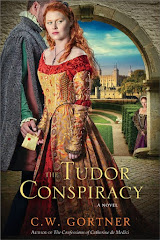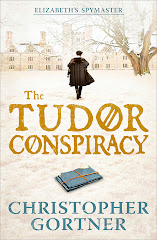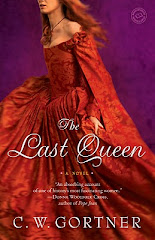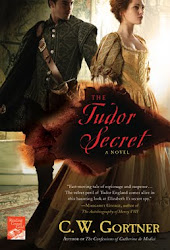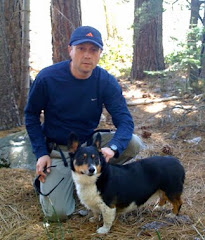 I'm delighted and honored to welcome Colin Falconer, acclaimed author of several historical novels, including the sumptuous The Sultan's Harem and one of my favorites on the infamous Cleopatra, WHEN WE WERE GODS. Years ago, before I was published and I was slogging through the submission/rejection/nervous breakdown cycle, Colin was one of my inspirations - a male historical fiction author who wrote gorgeous novels from both male, and female, points of view. In celebration of the recent release of When We Were Gods on Kindle, for a whole new generation of readers to enjoy, Colin has offered this marvelous guest post on the story behind his evocation of Egypt's last pharaoh.
I'm delighted and honored to welcome Colin Falconer, acclaimed author of several historical novels, including the sumptuous The Sultan's Harem and one of my favorites on the infamous Cleopatra, WHEN WE WERE GODS. Years ago, before I was published and I was slogging through the submission/rejection/nervous breakdown cycle, Colin was one of my inspirations - a male historical fiction author who wrote gorgeous novels from both male, and female, points of view. In celebration of the recent release of When We Were Gods on Kindle, for a whole new generation of readers to enjoy, Colin has offered this marvelous guest post on the story behind his evocation of Egypt's last pharaoh.Please join me in welcoming Colin Falconer!
I recently re-released a new edition of WHEN WE WERE GODS, my novel about Cleopatra, on Kindle. In revising and tightening the manuscript I was struck again by two things: first, what a fantastic story
 it is. If it wasn’t all true, it would be hard to believe: thirty years before Jesus, an eighteen year old princess tries to take over the world? Outrageous. Cleopatra was a woman with real cojones. She took on Roman military and political power at the apogee of its power. If she had succeeded – and she very nearly did – we can only speculate what the world would be like today. Because, contrary to popular belief, she didn’t spend all her time bathing in asses' milk, cozying up to Richard Burton and having her hair bobbed. The real Cleopatra was a consummate political animal, with extraordinary ambition, a rare talent for what we would today call spin and the instincts of a street fighter.
it is. If it wasn’t all true, it would be hard to believe: thirty years before Jesus, an eighteen year old princess tries to take over the world? Outrageous. Cleopatra was a woman with real cojones. She took on Roman military and political power at the apogee of its power. If she had succeeded – and she very nearly did – we can only speculate what the world would be like today. Because, contrary to popular belief, she didn’t spend all her time bathing in asses' milk, cozying up to Richard Burton and having her hair bobbed. The real Cleopatra was a consummate political animal, with extraordinary ambition, a rare talent for what we would today call spin and the instincts of a street fighter.The other thing that struck me – yet again - was what a tricky thing it is writing history. Like most historical fiction authors I have copped some criticism over the years for ‘getting it all wrong.’ From time to time a reviewer has criticised my research when in fact what they are criticising is my choice. Anyone who has done any sort of reading of the past will have found that most historians can never agree on anything. (It only takes one classical scholar in an empty room to start an argument.) What authors often have to do is make a best guess between two conflicting sets of theories. For example: for all her notoriety, we do not even know what Cleopatra really looked like.But surely, you say – she looked like Elizabeth Taylor?Well, no.
Some historians even speculate that Cleopatra may have been blonde. As she was part Macedonian, there's a fair chance, so to speak. I toyed with the idea of having Cleopatra as a
 blonde in WHEN WE WERE GODS, to show that I had done my research and to distance myself from the movie. (Also so that Scarlett Johanssen could play the role in my film. Or, at least, in my fantasies.) But my publisher said to me: you can't do that. (Have a blonde Cleopatra, not have fantasies about Scarlett Johanssen.) They said: Cleopatra is now far too deeply ingrained in our consciousness as Elizabeth Taylor in a bob, it will jar in a reader's imagination. A strange point, but a valid one. Cleopatra is now forever a brunette in the same way that Richard the Third will always be hunchbacked, thanks to Shakespeare.
blonde in WHEN WE WERE GODS, to show that I had done my research and to distance myself from the movie. (Also so that Scarlett Johanssen could play the role in my film. Or, at least, in my fantasies.) But my publisher said to me: you can't do that. (Have a blonde Cleopatra, not have fantasies about Scarlett Johanssen.) They said: Cleopatra is now far too deeply ingrained in our consciousness as Elizabeth Taylor in a bob, it will jar in a reader's imagination. A strange point, but a valid one. Cleopatra is now forever a brunette in the same way that Richard the Third will always be hunchbacked, thanks to Shakespeare.Let’s look at the evidence, ladies and gentlemen of the jury. Exhibit A: there are few existing likenesses of the lady extant. A coin from the period shows her in profile, and it’s a pretty terrifying image t
 oo, not unlike Mike Tyson. Exhibit B: two extremely ambiguous accounts from her contemporaries; Plutarch was at pains to describe her 'pleasing personality'. Only Cassius Dio said she was beautiful; but did he say that because he had to?So the evidence either way is sketchy, at best.
oo, not unlike Mike Tyson. Exhibit B: two extremely ambiguous accounts from her contemporaries; Plutarch was at pains to describe her 'pleasing personality'. Only Cassius Dio said she was beautiful; but did he say that because he had to?So the evidence either way is sketchy, at best.So I have imagined her in the book as she may have looked; her mother, after all, could have been a Syrian princess (we don't know that for sure either) and Syrian women were, and are, noted for exceptional beauty. But I didn’t play on it; in the context of the story, as in history, it was her spirit not her looks that really mattered. The woman had wit, fire and ambition to burn. She also ruled Egypt. If you were Caesar or Mark Antony, what’s not to like?But one thing even minimal research can do is quickly dispense with some of the more outrageous myths about her. She was not the sexual virago of legend; she did not copulate with crocodiles, (it's dangerous) or with her slaves (beneath her dignity). In fact, it seems she only slept with two men all her life, and both of them were husbands. Well, not her husbands, admittedly - but in all fairness, she did marry them later.
Dying by an asp bite to the breast? For those of you are contemplating it, suicide by this means is not advised. The breast is basically fatty tissue. It would be best to find a vein – the wrist, for example - which she may well have done - although other forms of poison cannot be ruled out. And finally let me assure you - and the scholars are pretty much one hundred per cent on this one - that she did not have a bob and a beauty spot; and Mark Antony did not talk with a Welsh accent and have a drinking problem. The truth - as far that can ever be ascertained - is far more interesting, no matter how you read it. And choosing how to write it - that's the joy of being a writer.WHEN WE WERE GODS, is now available on Kindle at $5.99.
Thank you, Colin! To learn more about Colin Falconer and his work, please visit his website and his blog at http://www.colinfalconer.net/the-man-with-the-past.html














